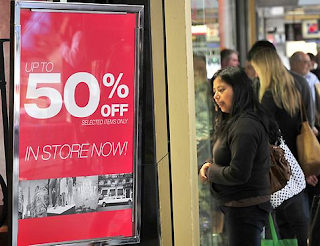Walmart Outlook for 2015

Labels: INDUSTRY-Retail-Stores, SECTOR-Consumer-Discretionary, Stocks, Stocks-2014-Q4, wmt

| Editor's Picks | Energy | Market Outlook | Gold | Real Estate | Stocks | Politics |
 |
The Wall Street Greek blog is the sexy & syndicated financial securities markets publication of former Senior Equity Analyst Markos N. Kaminis. Our stock market blog reaches reputable publishers & private networks and is an unbiased, independent Wall Street research resource on the economy, stocks, gold & currency, energy & oil, real estate and more. Wall Street & Greece should be as honest, dependable and passionate as The Greek.

Labels: INDUSTRY-Retail-Stores, SECTOR-Consumer-Discretionary, Stocks, Stocks-2014-Q4, wmt

Revised Oct. Change
|
Initial October Data
|
|
Retail Sales M/M Change
|
+0.6%
|
+0.4%
|
Retail Sales Less Autos
|
+0.5%
|
+0.2%
|
Retail Sales Less Autos &
Gas
|
+0.6%
|
+0.3%
|
November Change
|
Economists’ Consensus
|
|
Retail Sales M/M Change
|
+0.7%
|
+0.6%
|
Retail Sales Less Autos
|
+0.4%
|
+0.3%
|
Retail Sales Less Autos &
Gas
|
+0.6%
|
+0.2%
|

Labels: Economic-Reports, Economy, Economy-2013-Q4, Federal_Reserve, Federal-Reserve-2013-Q4, INDUSTRY-Retail-Stores, SECTOR-Consumer-Discretionary

Week Ended 10/5
|
Week Ended 9/28
|
|
ICSC Week-to-Week Change
|
-0.1%
|
+0.2%
|
ICSC Year-Over-Year Change
|
+1.8%
|
+2.1%
|
Redbook Year-to-Year Change
|
+3.3%
|
+3.8%
|
|
Security
|
Since September
|
Year-to-Date
|
|
SPDR S&P 500 (SPY)
|
-1.5%
|
+16.2%
|
|
Consumer Discretionary Select Sector SPDR (XLY)
|
-2.4%
|
+24.7%
|
|
SPDR S&P Retail (XRT)
|
-2.8%
|
+27.8%
|
|
Wal-Mart (WMT)
|
-1.4%
|
+6.8%
|
|
Amazon.com (AMZN)
|
-3.0%
|
+20.9%
|
Labels: consumers, Consumers-2013-Q4, Economy, Economy-2013-Q4, INDUSTRY-Retail-Stores, SECTOR-Consumer-Discretionary

 By The Greek:
By The Greek:
Labels: consumers, Consumers-2013-Q2, Economic-Reports, Economic-Reports-2013-Q2, Economy, Economy-2013-Q2, INDUSTRY-Retail-Stores, SECTOR-Consumer-Discretionary

| J.C. Penney (JCP) divergence from retail stocks (XRT). |
Labels: Editors_Picks, Editors-Picks-2013-Q1, INDUSTRY-Retail-Stores, JCP, Stocks, Stocks-2013-Q1


Labels: consumers, Consumers-2012-Q3, Economic-Reports, Economic-Reports-2012-Q3, Editors_Picks, Editors-Picks-2012-09, INDUSTRY-Retail-Stores, SECTOR-Consumer-Discretionary

 After falling precipitously in May, Consumer Confidence fell even further this month, to a 5-month low. The Conference Board’s Consumer Confidence Index declined to 62.0 in June, against economists’ expectations for a monthly reading of 63.5 based on Bloomberg’s survey. The index marked even lower ground than May’s dive to 64.4, revised down from 64.9 at its initial reporting. The reasons should be clear, as economic data points have trended poorly and European issues have raised question about impact to our economy, the financial system and the value of stocks. This strikes Americans where it hurts, their retirement savings accounts. The SPDR S&P 500 (NYSE: SPY) was essentially unchanged on the news, while the more closely tied Consumer Discretionary Select Sector SPDR (NYSE: XLY) was surprisingly higher by more than a half point Tuesday morning. Though the SPDR S&P Retail (NYSE: XRT) was moving lower, as would be expected.
After falling precipitously in May, Consumer Confidence fell even further this month, to a 5-month low. The Conference Board’s Consumer Confidence Index declined to 62.0 in June, against economists’ expectations for a monthly reading of 63.5 based on Bloomberg’s survey. The index marked even lower ground than May’s dive to 64.4, revised down from 64.9 at its initial reporting. The reasons should be clear, as economic data points have trended poorly and European issues have raised question about impact to our economy, the financial system and the value of stocks. This strikes Americans where it hurts, their retirement savings accounts. The SPDR S&P 500 (NYSE: SPY) was essentially unchanged on the news, while the more closely tied Consumer Discretionary Select Sector SPDR (NYSE: XLY) was surprisingly higher by more than a half point Tuesday morning. Though the SPDR S&P Retail (NYSE: XRT) was moving lower, as would be expected.
 Our founder earned clients a 23% average annual return over five years as a stock analyst on Wall Street. "The Greek" has written for institutional newsletters, Businessweek, Real Money, Seeking Alpha and others, while also appearing across TV and radio. While writing for Wall Street Greek, Mr. Kaminis presciently warned of the financial crisis.
Our founder earned clients a 23% average annual return over five years as a stock analyst on Wall Street. "The Greek" has written for institutional newsletters, Businessweek, Real Money, Seeking Alpha and others, while also appearing across TV and radio. While writing for Wall Street Greek, Mr. Kaminis presciently warned of the financial crisis.

Labels: consumers, Consumers-2012-Q2, Economic Reports, Economic-Reports-2012-Q2, Economy, Economy-2012-Q2, INDUSTRY-Retail-Stores, Service_Sector

Labels: consumers, Consumers-2012-Q2, Economic-Reports, Economic-Reports-2012-04, INDUSTRY-Retail-Stores, Service_Sector

 The close to last week offered up a sour tasting consumer report, and given the slew of related data produced through week, we thought we would take a look at the state of the American consumer today. The latest reporting of consumer confidence put a dent into the roaring market’s rise, with the SPDR Dow Jones Industrials Average ETF (NYSE: DIA) looking tired Friday. What I see in store for retail and the consumer discretionary sector is not as savory as the profits logged year-to-date therein.
The close to last week offered up a sour tasting consumer report, and given the slew of related data produced through week, we thought we would take a look at the state of the American consumer today. The latest reporting of consumer confidence put a dent into the roaring market’s rise, with the SPDR Dow Jones Industrials Average ETF (NYSE: DIA) looking tired Friday. What I see in store for retail and the consumer discretionary sector is not as savory as the profits logged year-to-date therein. Our founder earned clients a 23% average annual return over five years as a stock analyst on Wall Street. "The Greek" has written for institutional newsletters, Businessweek, Real Money, Seeking Alpha and others, while also appearing across TV and radio. While writing for Wall Street Greek, Mr. Kaminis presciently warned of the financial crisis.
Our founder earned clients a 23% average annual return over five years as a stock analyst on Wall Street. "The Greek" has written for institutional newsletters, Businessweek, Real Money, Seeking Alpha and others, while also appearing across TV and radio. While writing for Wall Street Greek, Mr. Kaminis presciently warned of the financial crisis.
Labels: consumers, Consumers-2012-Q1, Economic-Reports, Economic-Reports-2012-03, Economy, Economy-2012-03, INDUSTRY-Retail-Stores, SECTOR-Consumer-Goods

 Not long ago, Wall Street Greek warned investors to sell short the retail industry. You may not have noticed, as the call came out in the flurry of all the excitement about how great a holiday shopping season we had just concluded. Today, as the government reported the latest Retail Sales data for January, you may still have a chance to join the short side, with the SPDR S&P Retail ETF (NYSE: XRT) only down fractionally in morning trade Tuesday and still fattened 17.7% over the last 52-weeks by its superficial stride. Meanwhile, the SPDR Select Sector Fund - Consumer Discretionary ETF (NYSE: XLY) is up 9.5% over the last 52 weeks, both after adjustment for splits and dividends.
Not long ago, Wall Street Greek warned investors to sell short the retail industry. You may not have noticed, as the call came out in the flurry of all the excitement about how great a holiday shopping season we had just concluded. Today, as the government reported the latest Retail Sales data for January, you may still have a chance to join the short side, with the SPDR S&P Retail ETF (NYSE: XRT) only down fractionally in morning trade Tuesday and still fattened 17.7% over the last 52-weeks by its superficial stride. Meanwhile, the SPDR Select Sector Fund - Consumer Discretionary ETF (NYSE: XLY) is up 9.5% over the last 52 weeks, both after adjustment for splits and dividends. Our founder earned clients a 23% average annual return over five years as a stock analyst on Wall Street. "The Greek" has written for institutional newsletters, Businessweek, Real Money, Seeking Alpha and others, while also appearing across TV and radio. While writing for Wall Street Greek, Mr. Kaminis presciently warned of the financial crisis.
Our founder earned clients a 23% average annual return over five years as a stock analyst on Wall Street. "The Greek" has written for institutional newsletters, Businessweek, Real Money, Seeking Alpha and others, while also appearing across TV and radio. While writing for Wall Street Greek, Mr. Kaminis presciently warned of the financial crisis.
Labels: consumers, Economic-Reports, Economic-Reports-2012-02, Economy, Economy-2012-02, INDUSTRY-Retail-Stores, Service_Sector
